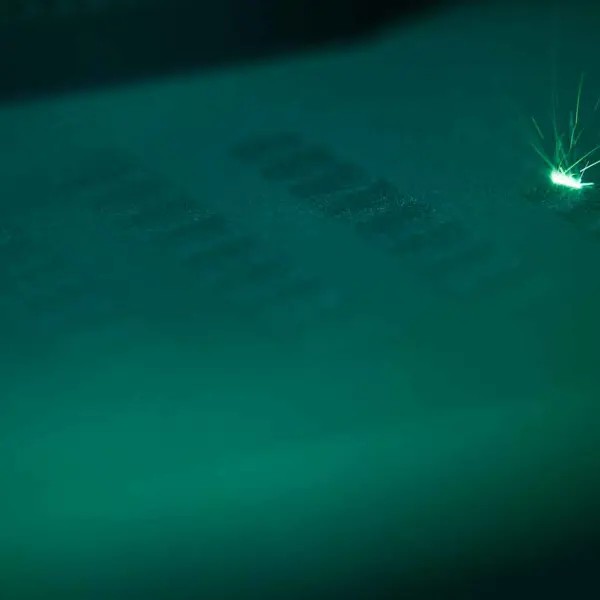
With a strong commitment to interdisciplinary research and sustainable development, Leif Asp sees materials science as the key to solving some of the major global challenges. Since 1 January this year, he is the new head of the Materials Science Area of Advance at Chalmers.
“I believe that materials science has a crucial role to play in the green transition, human health and in a sustainable society. Everything from energy generation, energy transport of electricity and energy storage, to lightweight solutions for road vehicles and aircraft, and implants and orthoses for patients in need. All this is dependent on constant material development and material availability,” says Leif Asp, Professor of Lightweight Composite Materials and Structures, at the Department of Industrial and Materials Science. His research focuses on multifunctional composites.
In this interview he shares his visions, focusing on everything from circular materials and materials for health, to breakthrough technologies and their potential for the transport sector.
“Society demands rapid access to better and sustainable materials, and circular material flows,’ says Leif Asp, pointing to major initiatives such as the Knut and Alice Wallenberg Research Foundation's Wallenberg Initiative Materials Science for Sustainability, WISE, and the EU's new Private Public Partnership IAM-I, Innovative Advanced Materials Initiative”, says Leif Asp. ”This shows how urgently industry and society view the availability of sustainable materials”.
It has been more than 10 years since Leif Asp left the research institute Swerea SICOMP for Chalmers. One of the reasons was the orgainsational structure with Areas of Advance, that increase the opportunities for interdisciplinary research.
“Since then, I have been very active in several different areas of advance and have seen the power of this part of our organisation. Through my research, which mainly focuses on material development, its synthesis, characterisation and modelling, I feel particularly at home in the Materials Science Area of Advance,” says Leif Asp
Through his commitment as Director of the Materials Science Area of Advance, Leif Asp hopes to create new opportunities for Chalmers' materials researchers and contribute to further strengthening research in the area.
“This is completely in the spirit of the work of Maria Abrahamsson, who I succeed, and Aleksandar Matíc before her,” says Leif Asp. For the past six years, he has been the Vice Director of Material Science. That role is now being taken on by Anna Ström, Professor at the Department of Chemistry and Chemical Engineering.
According to a report by the European Environment Agency, transport accounted for about a quarter of the EU's total carbon dioxide emissions in 2019, of which 71.7% came from road transport. The EU aims to reduce greenhouse gas emissions from transport by 90% by 2050 compared to 1990. This is part of the European Green Deal, which aims to decarbonise and achieve climate neutrality by 2050.
How can materials science help us reach our climate goals?
“We see examples in industry, such as the Hybrit project - production of carbon-free steel in Luleå, we have the electrification of road vehicles, hydrogen propulsion of future aircraft at Airbus. There are many examples. I myself am passionate about lightweight materials. By increasing the use of lightweight materials, we can further reduce energy consumption in the transport sector,” says Leif Asp.
Future transport solutions at EVS38
On 15-18 June, the City of Gothenburg will host the world's largest trade fair and conference in the field of electrified transport: Electric Vehicle Symposium and Exhibition, EVS38. At the conference, world-leading companies, researchers and politicians will meet to discuss, showcase and shape the future of electrified transport. Of course, Chalmers participates in the EVS scientific program and with activities in its own stand.
“There has been an unprecedented development of battery materials that has enabled the electrification of the vehicle fleet. There are, of course, a number of challenges for further development. One that immediately comes to mind is the availability of materials. It will be important to find solutions to increase the use of widely available materials. This could be replacing graphite in the anode or finding alternatives to cobalt in the cathode or replacing lithium with sodium. This type of research is taking place almost all over the world”.
Part of the government's COMPEL program
In recent years, electrochemistry and battery technology have been in focus at Chalmers, which has several strong research groups conducting research in battery technology.
“As a result, Chalmers is part of the government's COMPEL program, which is led by Aleksandar Matíc at Materials Physics. The activities there are particularly prominent. So are the activities in recycling technology at Chemistry and Chemical Engineering, led by Martina Petranikova,” says Leif Asp. ’During EVS we will showcase some of this research.
You have been a pioneer in the development of structural batteries. How can this technology revolutionise the transport sector and other industries?
“Multifunctional materials have great potential to increase efficiency in many applications. If you look specifically at the transport sector, you can see opportunities for weight reductions at the system level. Weight reductions immediately lead to reduced energy consumption in the transport sector. You can also see opportunities to free up volume (space) by replacing two monofunctional materials with a multifunctional one. In addition, I think we will appreciate the fact that material consumption is reduced at the system level”.
- Imagine going into space and carrying all the materials we need for repairs, construction and operation. If we can then use a material that can perform multiple functions, such as acting as an electrode, a conductor and a reinforcing material, as carbon fiber can, this creates obvious advantages.
Later this year, on 13-14 November, the Materials for Tomorrow conference will focus on bio-inspired materials.
What are the biggest opportunities with materials inspired by nature?
“Over millions of years of evolution, nature has developed efficient materials that are manufactured using energy-efficient processes and that can be broken down into their constituent parts without negative impact on the environment. Materials are often seen to have multiple functions in a single structure. We can learn about everything from energy-efficient and effective material synthesis, to how to make materials adapt to changing conditions (in mechanical loads or in the environment), to how materials can self-heal or extract energy from the environment. I think our imagination is the only thing that limits us here.”
Materials science also has great potential in health and healthcare, from synthetic bones to smart medical devices.
“As I have already mentioned, materials technology is crucial for the health sector. Within the Area of Advance, Chalmers and the University of Gothenburg have extremely strong research collaboration in materials for health. One such area is materials for implants (so-called biomaterials) where the Chalmers Centre CAM2 and the University of Gothenburg's Biomaterials research department collaborate.”
What are the opportunities when it comes to creating circular systems for material utilisation?
“There are many challenges. The process industry and end users will need to work together at a societal level. Therefore, research in materials science and production technology also needs to be conducted in some collaboration. I also see a need for us researchers to become better at assessing sustainability in the early stages of our research. This is needed to increase our ability to assess and analyze the materials being developed already during the planning phase and in our laboratories,” says Leif Asp.



